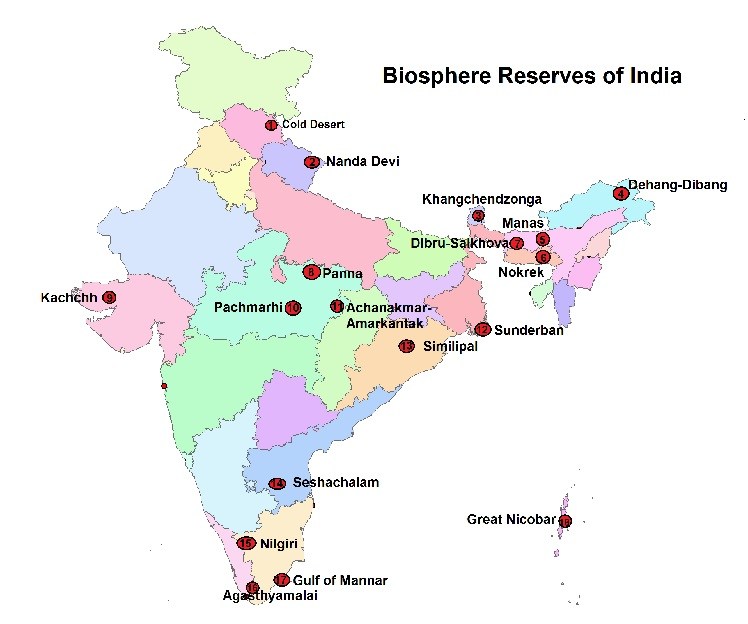Biosphere reserves
- Biosphere reserves are areas of terrestrial and coastal ecosystems which promote conservation of biodiversity with its sustainable use.
- They serve in some ways as ‘living laboratories’ for testing out and demonstrating integrated management of land, water and biodiversity.
- They are internationally recognized within framework of UNESCO’s Man and Biosphere (MAB) programme and nominated by national governments.
- There is World Network of Biosphere Reserves (WNBR) under MAB Programme.
- Within this network, exchanges of information, experience and personnel are facilitated.
- There are over 500 biosphere reserves in over 100 countries.
- India has total 18 Biosphere Reserves and with inclusion of Khangchendzonga number of internationally designated WNBR has become 11 and remaining 7 Biosphere Reserves are domestic Biosphere Reserves.
Man & Biosphere Programme
- UNESCO’s Man and the Biosphere (MAB) Programme was launched in 1971 with aim of promoting interdisciplinary research, training, and communications in field of ecosystem conservation and rational use of natural resources.
- The programme is suited to respond to results of the 1992 United Nations Conference on Environment and Development (UNCED) and especially the objectives of the Convention on Biological Diversity.
Selection of Biosphere Reserves
- Primary Criteria:
- Site must contain effectively protected and minimally disturbed core area of value of nature conservation.
- It should also include additional land and water suitable for research and demonstration of sustainable methods of research and management.
- Its core area should be typical of biogeographical unit and large enough to sustain viable populations representing all trophic levels in the ecosystem.
- Secondary Criteria:
- Areas having rare and endangered species, Areas having diversity of soil and micro-climatic conditions and indigenous varieties of biota, Areas potential for preservation of traditional tribal or rural modes of living for harmonious use of environment.

In below table, Bold ones are in World Network of Biosphere Reserves (WNBR)
|
Sl. No |
Year |
Name |
State |
Type |
Key Fauna |
|
1 |
1989 |
Gulf of Mannar |
Tamil Nadu |
Coasts |
Dugong or Sea Cow |
|
2 |
1989 |
Sundarbans |
West Bengal |
Gangetic Delta |
Royal Bengal Tiger |
|
3 |
1988 |
Nanda Devi |
Uttarakhand |
Western Himalayas |
NA |
|
4 |
1986 |
Nilgiri Biosphere Reserve |
Tamil Nadu, Kerala and Karnataka |
Western Ghats |
Nilgiri Tahr, Lion-tailed macaque |
|
5 |
1999 |
Pachmarhi Biosphere Reserve |
Madhya Pradesh |
Semi-Arid |
Giant Squirrel, Flying Squirrel |
|
6 |
1994 |
Simlipal |
Odisha |
Deccan Peninsula |
Gaur, Royal Bengal Tiger, Wild elephant |
|
7 |
2005 |
Achanakamar -Amarkantak |
Madhya Pradesh, Chhattisgarh |
Maikala Hills |
NA |
|
8 |
2000 |
Khangchendzonga |
Sikkim |
East Himalayas |
Snow Leopard, Red Panda |
|
9 |
1989 |
Great Nicobar Biosphere Reserve |
Andaman and Nicobar Islands |
Islands |
Saltwater Crocodile |
|
10 |
1988 |
Nokrek |
Meghalaya |
East Himalayas |
Red Panda |
|
11 |
2001 |
Agasthyamalai Biosphere Reserve |
Kerala, Tamil Nadu |
Western ghats |
Nilgiri Tahr, Elephants |
|
12 |
1997 |
Dibru-Saikhowa |
Assam |
East Himalayas |
Golden Langur |
|
13 |
2008 |
Great Rann of Kutch |
Gujarat |
Desert |
Indian Wild Ass
|
|
14 |
2009 |
Cold Desert |
Himachal Pradesh |
Western Himalayas |
Snow Leopard |
|
15 |
1998 |
Dihang-Dibang |
Arunachal Pradesh |
Eastern Himalaya |
NA |
|
16 |
2010 |
Seshachalam Hills |
Andhra Pradesh |
Eastern Ghats |
NA |
|
17 |
1989 |
Manas |
Assam |
East Himalayas |
Golden Langur, Red Panda |
|
18 |
2011 |
Panna |
Madhya Pradesh |
Ken River |
Tiger, Chital, Chinkara, Sambharand Sloth bear |